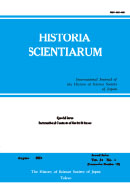31 巻, 1 号
選択された号の論文の7件中1~7を表示しています
- |<
- <
- 1
- >
- >|
Special Issue : International Contacts of Soviet Sciences
-
2021 年 31 巻 1 号 p. 1-2
発行日: 2021/08/31
公開日: 2023/02/01
PDF形式でダウンロード (162K) -
2021 年 31 巻 1 号 p. 3-19
発行日: 2021/08/31
公開日: 2023/02/01
PDF形式でダウンロード (680K) -
2021 年 31 巻 1 号 p. 20-30
発行日: 2021/08/31
公開日: 2023/02/01
PDF形式でダウンロード (289K) -
2021 年 31 巻 1 号 p. 31-46
発行日: 2021年
公開日: 2023/02/01
PDF形式でダウンロード (328K) -
2021 年 31 巻 1 号 p. 47-71
発行日: 2021/08/31
公開日: 2023/02/01
PDF形式でダウンロード (861K) -
2021 年 31 巻 1 号 p. 72-86
発行日: 2021/08/31
公開日: 2023/02/01
PDF形式でダウンロード (315K)
Review
-
2021 年 31 巻 1 号 p. 87-90
発行日: 2021/08/31
公開日: 2023/02/01
PDF形式でダウンロード (227K)
- |<
- <
- 1
- >
- >|
